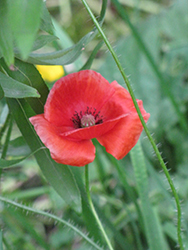It's all about ...
plants

Height: 16 inches
Spacing: 10 inches
Sunlight:
![]()
![]()
Hardiness Zone: (annual)
Other Names: Common Poppy, Corn Poppy, Field Poppy
Description:
This fast growing variety has great flower power, producing beautiful scarlet red blooms; beautiful massed as a border planting; self seeding annual; used for memorials
Ornamental Features
Flanders Poppy features bold scarlet round flowers with black centers at the ends of the stems from early spring to early fall. The flowers are excellent for cutting. Its tomentose ferny leaves remain light green in colour throughout the season.
Landscape Attributes
Flanders Poppy is an open herbaceous annual with tall flower stalks held atop a low mound of foliage. It brings an extremely fine and delicate texture to the garden composition and should be used to full effect.
This plant will require occasional maintenance and upkeep. Trim off the flower heads after they fade and die to encourage more blooms late into the season. Deer don't particularly care for this plant and will usually leave it alone in favor of tastier treats. Gardeners should be aware of the following characteristic(s) that may warrant special consideration;
- Self-Seeding
Flanders Poppy is recommended for the following landscape applications;
- Mass Planting
- Rock/Alpine Gardens
- General Garden Use
Planting & Growing
Flanders Poppy will grow to be about 14 inches tall at maturity, with a spread of 12 inches. When grown in masses or used as a bedding plant, individual plants should be spaced approximately 10 inches apart. This fast-growing annual will normally live for one full growing season, needing replacement the following year. However, this species tends to self-seed and may thereby endure for years in the garden if allowed. As this plant tends to go dormant in summer, it is best interplanted with late-season bloomers to hide the dying foliage.
This plant does best in full sun to partial shade. It does best in average conditions that are neither too wet nor too dry, and is very intolerant of standing water. It is not particular as to soil type or pH. It is somewhat tolerant of urban pollution. This species is not originally from North America.
